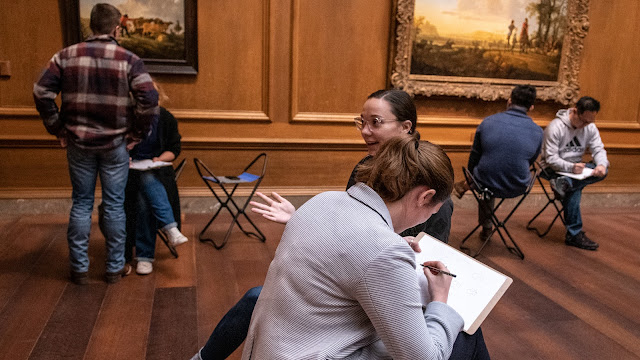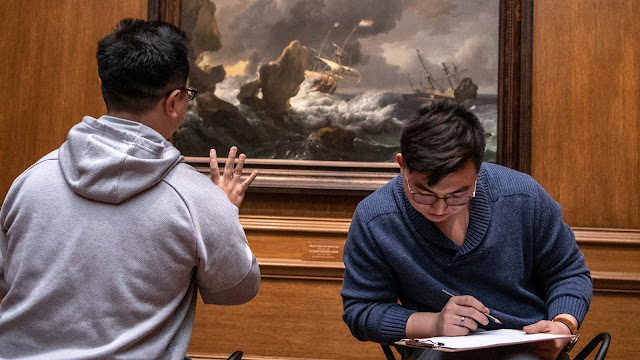The Art of Healthcare: Learning How Humanism Impacts Military Medicine
Uniformed Services University (USU) medical students and faculty travel to the National Gallery of Art in Washington, D.C. as part of humanities curriculum.
 |
Medical school students from USU traveled to the National Gallery of Art in Washington, D.C. to learn about the role of art in medicine. (Photo credit: Tom Balfour, USU) |
April 6th, 2023 By Ian Neligh
Medical school students and faculty from the Uniformed Services University of the Health Sciences (USU) recently traveled to the National Gallery of Art in Washington, D.C., to help strengthen their understanding of the role the arts play in the practice of medicine.
The trip to the museum provided the university students with one aspect of the larger humanism curriculum designed to build a connection between the future physicians, their patients, and the role of art in caregiving which they typically undertake after their clerkships.
Navy Lt. Cmdr. (Dr.) Sebastian Lara, associate professor, Department of Pediatrics and director of the B3 (Bench to Bedside and Beyond) Humanities curriculum says one of the most important skills to learn is how to reflect on yourself and how to interact with other people.
“Not only are the students going to use these skills as physicians but they’re also going to use them as military officers,” Lara says. “In the military you’ll be leading people, and at USU, these skills of empathy and self-reflection are critical for being a leader.”
‘The power of observation’
USU medical students returning from their clerkships are offered a multi-day course titled “Humanism in Medicine” to better learn about the role of the humanities in healing during their B3 module.
The week-long course held at the end of March includes everything from painting to making comics, creating video games, mask making, learning improv, writing, and music, each with relevance to some aspect of patient care.
For the first time since COVID-19, the students also traveled to the National Gallery where they learned from art historians. One of the largest museums in North America, and the fifth most-visited art museum in the world, the National Gallery of Art provided the perfect opportunity for students to learn about humanism in medicine.
Lara says the paintings and art in the gallery are used to help the students think about observation.
“We all see different things in one piece of art, I think it translates to how … multiple students can look at one patient and see different features of the diagnoses,” says Lara. “How do you talk about that? And how do you express that out loud? It boils down to ‘we take care of human beings and we are human beings as physicians and medical professionals.’”
Family medicine assistant professor, and co-director of the Humanism in Medicine course Dr. Elyse Pierre says this type of education helps future physicians learn how to be aware of their perspective and how that might ultimately impact the way that they interact with their colleagues and patients. As an example, she says students who learn about improvisational acting learn an important tool for communicating.
“Improv is just ‘back and forth,’ a way of acting and interacting with folks but in that communication, you do have to listen and hear what the other person is saying before you respond or it doesn’t make any sense,” Pierre says. She adds building that skill helps in working with both colleagues and patients. “So the practice of using that skill and then having fun … (helps in) trying to be empathetic, truly listening and reflecting in those conversations.”
Pierre says each of the workshops is intended to use those mediums to help the students express themselves and reflect on the experiences that they have had in their clinical clerkships over the last 12 months.
“It’s our first time to come back after those clerkships … and reflect on the experiences that they had, both positive and negative,” Pierre says.
‘A human experience’
Air Force Lt. Col. (Dr.) Jeanmarie Rey, assistant professor of Family Medicine and the Reflective Practice director, says about 20 USU faculty members also recently went to the National Gallery on a separate trip to get a sense of what the students experienced and learned from art.
“I am very passionate about humanism in medicine and want to make sure that we are growing the next generation of military physicians to be holistic and to include the whole person,” says Rey. “The idea of treating an illness as a human experience, not just disease which is pathology.”
Rey says that USU faculty benefit from going to the National Gallery of Art just as much as the students.
“It’s great to simply enjoy the experience and to spend quality time building community with other faculty at USU,” Rey says. “This was just a great way to get people together to appreciate art — but it also allowed us as a community of faculty to experience what our students are also experiencing, so we can help to connect the dots for them.”
Faculty were invited to attend the curriculum at the museum from the university’s pediatrics and family medicine departments. Rey says the faculty engaged in small group discussions where they could talk about the impact of art in their lives and then spent time in the museum’s west building observing art.
They then took part in an activity where they were paired off and one person looked at a piece of art while the other person had their back turned to it and had to draw based on their partner’s description.
“It’s a cool activity because it demonstrates what we’re trying to teach the medical students about vulnerability” Rey says. “You don’t always know the whole picture and you’re relying on someone else to explain what is going on.”
Rey says the exercise helps clinicians understand both the importance and limits of communication. She added part of the goal was to see how the practice of medicine is both a skill and an art.
“You can have all the medical knowledge in the world and be a very skilled clinician as far as your ability to synthesize data, make a diagnosis, and come up with good treatment plans,” Rey says. “But if you cannot connect with another human being, then there’s a lot of missed opportunity for clinical impact.”
 |
USU's humanism in medicine curriculum was designed to help build a connection between the future physicians, their patients, and the role of art in caregiving. (Photo credit: Tom Balfour, USU) |
USU faculty member Air Force Maj. Dr. Alexander Ulfers says it was educational to see what the medical students were learning during their portion of the humanism curriculum.
“I loved it,” Ulfers says. “I think they did a really good job of framing medical discussions in a non-medical way. Sometimes as physicians, I think we get so wrapped up in the world of biology and physiology and all these complicated pathways and… we sometimes forget that conversations with a patient are still conversations with a person.”
During one portion of the museum curriculum, faculty members sat together as a group and discussed what they saw in a large painting.
“Literally every single one of us had a different interpretation,” Ulfers says. “Some of our interpretations aligned to where we were sitting in the room, and some of them aligned by the type of medicine that we did — but we were all looking at the same picture.”
Through the lens of viewing this painting as a group, Ulfers says he understood exactly what the value of the curriculum was.
“It was a great reminder that even when we’re all looking at the same patient, [we’re doing it] differently.”





